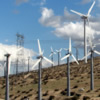Cohoton Wind Watch (New York), August 25, 2008
They say let us clear the air together, do they mean let us befoul the North Country? The wind industry’s development of a giant industrial complex aka a “wind farm” produces large amounts of greenhouse gases as well as significant mercury pollution.

Processing the steel for turbine bodies produces about 2 tons of carbon-based emissions for each ton of steel. Plus the emissions from mining and transport. Since most wind turbines are manufactured offshore ocean transport involves large distances and consequently large amounts of emissions.
Once a turbine arrives at a port of entry like Albany it must be transported to the project site. Each turbine requires 6 or 7 trips by truck to be moved. According to EPA, measurements 4 lbs. of carbon-based emissions are produced per mile. Trucks hauling sand and gravel long distance emit upwards of 250 lbs. of carbon dioxide per trip (that’s the main culprit in global warming.) and with hundreds of trips /day tons of emissions are produced daily. Concurrently, each loader, bulldozer, and excavator is emitting about 100 lbs. of CO2 per hour. Add to this 1000’s of private cars and trucks driven in some cases long distances by those involved in a wind project. Many projects involve destroying large numbers of trees, each a carbon sink that truly helps clear the air.
Here in the North Country mercury pollution associated with wind projects may be more of an immediate concern than carbon emissions. The source of mercury is in the processing of cement. Cement is made from limestone, all of which contains some mercury. The median amount of mercury released into the air is 1.5 lbs. per ton of cement. The average turbine base contains 325 cu. yd. of concrete made with approx. 90 tons of cement. This mercury is released directly into the air at the cement plants.
Recent media hype has focused on the dangers of mercury in compact fluorescent lamps ( CFL’s ). However, more mercury is released directly into the air from the cement used in a single wind turbine base than is encapsulated in over a MILLION CFL’s.
A recent calculation by scientists from the Pacific Research Institute, a West Coast think tank that supplies input to some of the leading newspapers and magazines in the country shows wind turbines need to operate for 7 years at full capacity to avoid the carbon emissions produced in building them. In the low 1, 2 and 3 class winds of northern NY turbines run at best in the 25% capacity factor range. This means 28 years to break even, longer than most estimates of their useful life.
It appears that wind developers claim of completely pollution free production of electricity is at best an exaggeration at worst a bold-faced lie.
Wind Power Pollution
Jack Sullivan
Cohoton Wind Watch (New York), August 25, 2008
They say let us clear the air together, do they mean let us befoul the North Country? The wind industry’s development of a giant industrial complex aka a “wind farm” produces large amounts of greenhouse gases as well as significant mercury pollution.
Processing the steel for turbine bodies produces about 2 tons of carbon-based emissions for each ton of steel. Plus the emissions from mining and transport. Since most wind turbines are manufactured offshore ocean transport involves large distances and consequently large amounts of emissions.
Once a turbine arrives at a port of entry like Albany it must be transported to the project site. Each turbine requires 6 or 7 trips by truck to be moved. According to EPA, measurements 4 lbs. of carbon-based emissions are produced per mile. Trucks hauling sand and gravel long distance emit upwards of 250 lbs. of carbon dioxide per trip (that’s the main culprit in global warming.) and with hundreds of trips /day tons of emissions are produced daily. Concurrently, each loader, bulldozer, and excavator is emitting about 100 lbs. of CO2 per hour. Add to this 1000’s of private cars and trucks driven in some cases long distances by those involved in a wind project. Many projects involve destroying large numbers of trees, each a carbon sink that truly helps clear the air.
Here in the North Country mercury pollution associated with wind projects may be more of an immediate concern than carbon emissions. The source of mercury is in the processing of cement. Cement is made from limestone, all of which contains some mercury. The median amount of mercury released into the air is 1.5 lbs. per ton of cement. The average turbine base contains 325 cu. yd. of concrete made with approx. 90 tons of cement. This mercury is released directly into the air at the cement plants.
Recent media hype has focused on the dangers of mercury in compact fluorescent lamps ( CFL’s ). However, more mercury is released directly into the air from the cement used in a single wind turbine base than is encapsulated in over a MILLION CFL’s.
A recent calculation by scientists from the Pacific Research Institute, a West Coast think tank that supplies input to some of the leading newspapers and magazines in the country shows wind turbines need to operate for 7 years at full capacity to avoid the carbon emissions produced in building them. In the low 1, 2 and 3 class winds of northern NY turbines run at best in the 25% capacity factor range. This means 28 years to break even, longer than most estimates of their useful life.
It appears that wind developers claim of completely pollution free production of electricity is at best an exaggeration at worst a bold-faced lie.
Nothing contained in this blog is to be construed as necessarily reflecting the views of the Pacific Research Institute or as an attempt to thwart or aid the passage of any legislation.